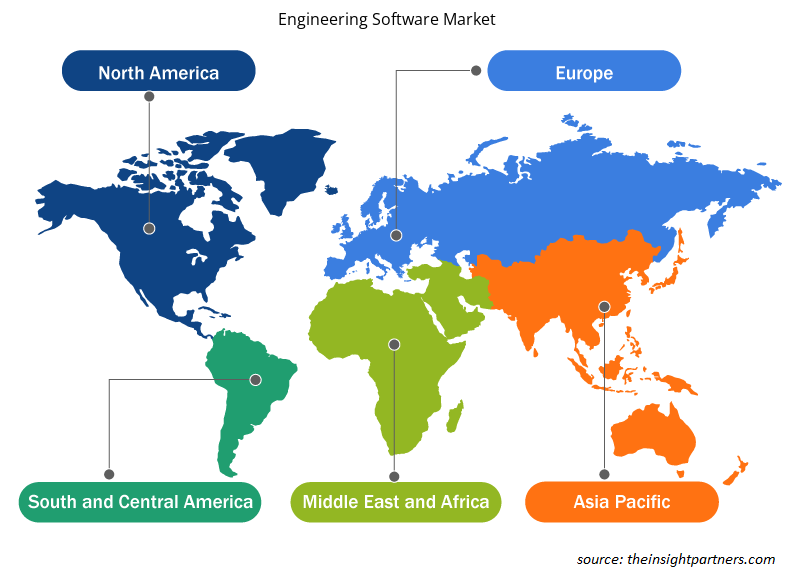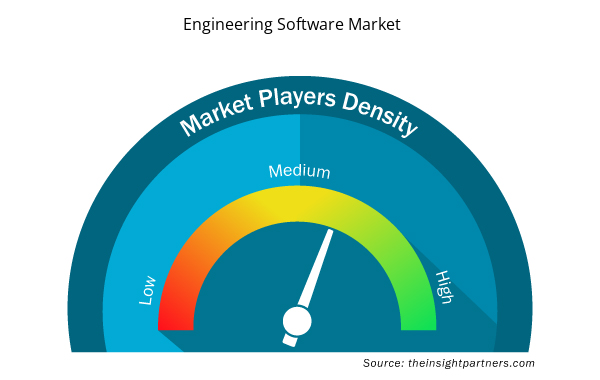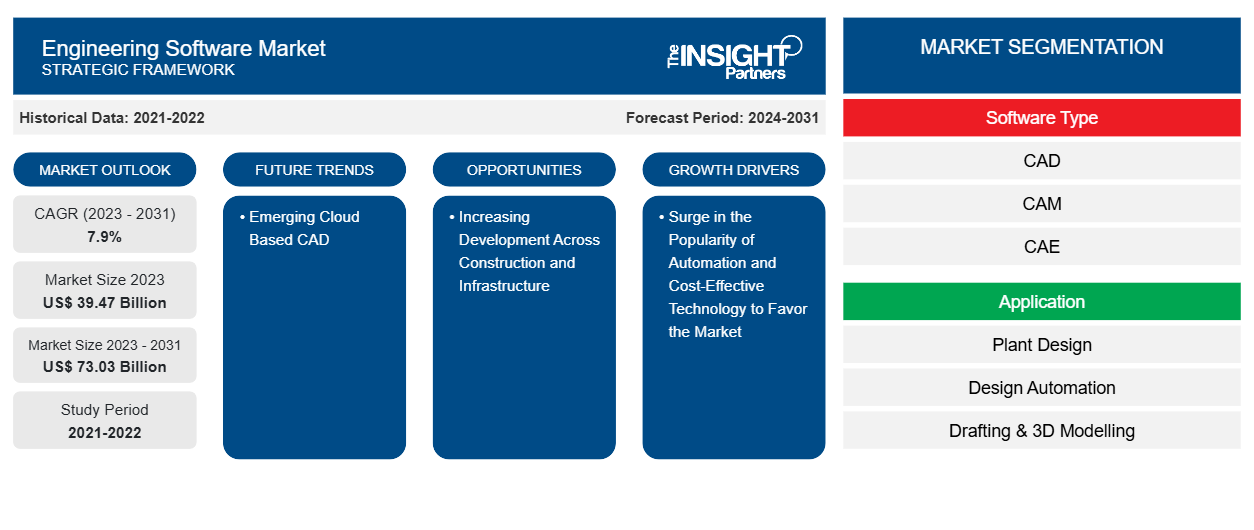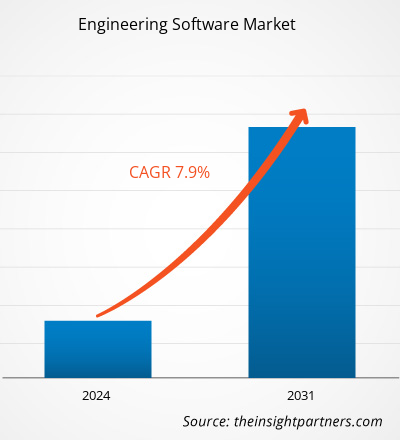من المتوقع أن يصل حجم سوق البرمجيات الهندسية إلى 73.03 مليار دولار أمريكي بحلول عام 2031 من 39.47 مليار دولار أمريكي في عام 2023. ومن المتوقع أن يسجل السوق معدل نمو سنوي مركب بنسبة 7.9٪ في الفترة من 2023 إلى 2031. ومن المرجح أن يظل الارتفاع في شعبية الأتمتة والتكنولوجيا الفعالة من حيث التكلفة من الاتجاهات الرئيسية لسوق البرمجيات الهندسية.
تحليل سوق البرمجيات الهندسية
إن الاستخدام المتزايد لبرامج التصميم بمساعدة الحاسوب (CAD) والتصميم بمساعدة الحاسوب (CAE) في مجموعة من الصناعات، بما في ذلك قطاعات السيارات والفضاء والبناء والرعاية الصحية، هو المسؤول عن توسع السوق. تشمل برامج الهندسة، من بين أمور أخرى، التصميم بمساعدة الحاسوب (CAD)، والتصنيع بمساعدة الحاسوب (CAM)، والهندسة بمساعدة الحاسوب (CAE). ومن المتوقع أن يتوسع سوق برامج الهندسة بشكل كبير طوال فترة التنبؤ لعدة أسباب، بما في ذلك الطلب المتزايد على الشركات لتقصير الوقت ونفقات تطوير المنتجات.
نظرة عامة على سوق البرمجيات الهندسية
يمكن للمهندسين والمصممين والمصنعين كتابة وثائق هندسية بالغة الأهمية، وتحليل ومحاكاة أداء المنتج وعملياته، وتطوير نماذج معقدة بمساعدة حلول برمجيات الهندسة. مع الحلول المستندة إلى السحابة، يمكن لأعضاء الفريق التعاون عن بُعد باستخدام أي جهاز يختارونه لأنه يمكن الوصول إليه من خلال متصفح الويب. ونتيجة لذلك، يمكن للشركات تحديث وتقليل نفقات الأجهزة دون التضحية بالقوة الحسابية أو الفائدة.
قم بتخصيص هذا التقرير ليناسب متطلباتك
ستحصل على تخصيص لأي تقرير - مجانًا - بما في ذلك أجزاء من هذا التقرير، أو تحليل على مستوى الدولة، وحزمة بيانات Excel، بالإضافة إلى الاستفادة من العروض والخصومات الرائعة للشركات الناشئة والجامعات
- احصل على أهم اتجاهات السوق الرئيسية لهذا التقرير.ستتضمن هذه العينة المجانية تحليلاً للبيانات، بدءًا من اتجاهات السوق وحتى التقديرات والتوقعات.
محركات وفرص سوق البرمجيات الهندسية
ارتفاع شعبية الأتمتة والتكنولوجيا الفعالة من حيث التكلفة لصالح السوق.
تتعرض شركات الهندسة والتوريد والبناء في جميع أنحاء العالم لضغوط لتقليل أخطاء الإنتاج والنفقات التشغيلية بسبب المنافسة المتزايدة في السوق. يمكن لمهندسي المصانع تحسين الجودة من خلال اتباع معايير دولية معينة أثناء عمليات التصميم والإنتاج والتشغيل. يمكن حل مشكلات الإنتاج والكثافة باستخدام برامج التصميم والتحليل المستمر والترقيات القياسية. ونتيجة لذلك، تستخدم الشركات في جميع أنحاء العالم برامج الهندسة بشكل متزايد لتقليل الأخطاء في البناء والإنتاج.
زيادة التنمية في مجال البناء والبنية التحتية
يُعتقد أن البناء هو أحد العوامل الرئيسية التي تساهم في التنمية الاجتماعية والاقتصادية لأي بلد. تتوسع صناعة البناء بسرعة في الدول النامية حول العالم، بما في ذلك إثيوبيا والهند والصين والبرازيل وأوزبكستان وكمبوديا وتنزانيا وميانمار. كما تتطور البنية التحتية الأساسية لهذه الاقتصادات بمعدل سريع. على سبيل المثال، تجتذب الاقتصادات النامية في آسيا والمحيط الهادئ وجنوب إفريقيا الكثير من الاستثمار الأجنبي المباشر في تطوير البنية التحتية الخاصة بها. ستحفز هذه التطورات أيضًا نمو بنيتها التحتية، ومع توسع صناعة البناء، ستزداد الحاجة إلى برامج الهندسة. لذلك، من المتوقع أن تقدم التطورات المتزايدة في البنية التحتية وقطاعات الأعمال الإنشائية المزيد من الفرص.
تقرير تحليل تجزئة سوق البرمجيات الهندسية
إن القطاعات الرئيسية التي ساهمت في استخلاص تحليل سوق البرمجيات الهندسية هي نوع البرنامج والتطبيق.
- بناءً على نوع البرنامج، ينقسم سوق برامج الهندسة إلى CAD وCAM وCAE وAEC وEDA. ومن المتوقع أن ينمو قطاع CAD في الفترة المتوقعة.
- من حيث التطبيق، يتم تقسيم السوق إلى تصميم المصانع، وأتمتة التصميم ، والرسم والنمذجة ثلاثية الأبعاد، وتصميم المنتجات واختبارها، وغيرها. ومن المتوقع أن ينمو قطاع أتمتة التصميم في الفترة المتوقعة.
تحليل حصة سوق البرمجيات الهندسية حسب المنطقة الجغرافية
ينقسم النطاق الجغرافي لتقرير سوق برمجيات الهندسة بشكل أساسي إلى خمس مناطق: أمريكا الشمالية، ومنطقة آسيا والمحيط الهادئ، وأوروبا، والشرق الأوسط وأفريقيا، وأمريكا الجنوبية/أمريكا الجنوبية والوسطى. سيطرت أمريكا الشمالية على سوق برمجيات الهندسة. وقد أدت اتجاهات تبني التكنولوجيا العالية في مختلف الصناعات في منطقة أمريكا الشمالية إلى تغذية نمو سوق برمجيات الهندسة. ومن المتوقع أن تؤدي عوامل مثل زيادة تبني الأدوات الرقمية والإنفاق التكنولوجي المرتفع من قبل الوكالات الحكومية إلى دفع نمو سوق برمجيات الهندسة في أمريكا الشمالية. علاوة على ذلك، فإن التركيز القوي على البحث والتطوير في الاقتصادات المتقدمة في الولايات المتحدة وكندا يجبر اللاعبين في أمريكا الشمالية على جلب حلول متقدمة تقنيًا إلى السوق. بالإضافة إلى ذلك، يوجد في الولايات المتحدة عدد كبير من اللاعبين في سوق برمجيات الهندسة الذين يركزون بشكل متزايد على تطوير حلول مبتكرة. تساهم كل هذه العوامل في نمو سوق برمجيات الهندسة في المنطقة.
رؤى إقليمية حول سوق البرمجيات الهندسية
لقد قام المحللون في Insight Partners بشرح الاتجاهات والعوامل الإقليمية المؤثرة على سوق برمجيات الهندسة طوال فترة التوقعات بشكل شامل. يناقش هذا القسم أيضًا قطاعات سوق برمجيات الهندسة والجغرافيا في جميع أنحاء أمريكا الشمالية وأوروبا ومنطقة آسيا والمحيط الهادئ والشرق الأوسط وأفريقيا وأمريكا الجنوبية والوسطى.

- احصل على البيانات الإقليمية المحددة لسوق برمجيات الهندسة
نطاق تقرير سوق برمجيات الهندسة
| سمة التقرير | تفاصيل |
|---|---|
| حجم السوق في عام 2023 | 39.47 مليار دولار أمريكي |
| حجم السوق بحلول عام 2031 | 73.03 مليار دولار أمريكي |
| معدل النمو السنوي المركب العالمي (2023 - 2031) | 7.9% |
| البيانات التاريخية | 2021-2022 |
| فترة التنبؤ | 2024-2031 |
| القطاعات المغطاة | حسب نوع البرنامج
|
| المناطق والدول المغطاة | أمريكا الشمالية
|
| قادة السوق وملفات تعريف الشركات الرئيسية |
|
كثافة اللاعبين في سوق البرمجيات الهندسية: فهم تأثيرها على ديناميكيات الأعمال
يشهد سوق البرمجيات الهندسية نموًا سريعًا، مدفوعًا بالطلب المتزايد من المستخدم النهائي بسبب عوامل مثل تفضيلات المستهلك المتطورة والتقدم التكنولوجي والوعي المتزايد بفوائد المنتج. ومع ارتفاع الطلب، تعمل الشركات على توسيع عروضها والابتكار لتلبية احتياجات المستهلكين والاستفادة من الاتجاهات الناشئة، مما يؤدي إلى زيادة نمو السوق.
تشير كثافة اللاعبين في السوق إلى توزيع الشركات أو المؤسسات العاملة في سوق أو صناعة معينة. وهي تشير إلى عدد المنافسين (اللاعبين في السوق) الموجودين في مساحة سوق معينة نسبة إلى حجمها أو قيمتها السوقية الإجمالية.
الشركات الرئيسية العاملة في سوق البرمجيات الهندسية هي:
- بي تي سي
- شركة روكويل للأتمتة
- ساب اس اي
- سيمنز
- شركة سينوبسيس
- شركة أوتوديسك
إخلاء المسؤولية : الشركات المذكورة أعلاه ليست مرتبة بأي ترتيب معين.

- احصل على نظرة عامة على أهم اللاعبين الرئيسيين في سوق برمجيات الهندسة
أخبار سوق البرمجيات الهندسية والتطورات الأخيرة
يتم تقييم سوق برمجيات الهندسة من خلال جمع البيانات النوعية والكمية بعد البحث الأولي والثانوي، والتي تتضمن منشورات الشركات المهمة وبيانات الجمعيات وقواعد البيانات. فيما يلي قائمة بالتطورات في السوق:
- في فبراير 2024، تهدف شركة التكنولوجيا العالمية Cognizant إلى تسريع تحديث الأعمال من خلال توسيع مجموعة عروض المنصات الخاصة بها. أعلنت الشركة عن إطلاق Cognizant Flowsource، وهي منصة توليدية مدعمة بالذكاء الاصطناعي مصممة لتشغيل عصر جديد من هندسة البرمجيات.
(المصدر: Cognizant، بيان صحفي، 2024)
- في يونيو 2023، تم إطلاق Nullspace, Inc. كشركة فرعية من IERUS Technologies، وهي شركة مقاولات دفاعية راسخة في هانتسفيل، ألاباما. تركز Nullspace, Inc. على تقديم برامج هندسية متقدمة لتطبيقات الكهرومغناطيسية.
(المصدر: Nullspace، بيان صحفي، 2023)
تغطية تقرير سوق برمجيات الهندسة والمنتجات النهائية
يوفر تقرير "حجم سوق برمجيات الهندسة والتوقعات (2021-2031)" تحليلاً مفصلاً للسوق يغطي المجالات التالية:
- حجم السوق والتوقعات على المستويات العالمية والإقليمية والوطنية لجميع قطاعات السوق الرئيسية التي يغطيها النطاق
- ديناميكيات السوق مثل المحركات والقيود والفرص الرئيسية
- الاتجاهات المستقبلية الرئيسية
- تحليل مفصل لقوى PEST/Porter الخمس وSWOT
- تحليل السوق العالمي والإقليمي الذي يغطي اتجاهات السوق الرئيسية واللاعبين الرئيسيين واللوائح والتطورات الأخيرة في السوق
- تحليل المشهد الصناعي والمنافسة الذي يغطي تركيز السوق، وتحليل خريطة الحرارة، واللاعبين البارزين، والتطورات الأخيرة
- ملفات تعريف الشركة التفصيلية
- التحليل التاريخي (سنتان)، السنة الأساسية، التوقعات (7 سنوات) مع معدل النمو السنوي المركب
- تحليل PEST و SWOT
- حجم السوق والقيمة / الحجم - عالميًا وإقليميًا وقطريًا
- الصناعة والمنافسة
- مجموعة بيانات Excel


- Lymphedema Treatment Market
- Identity Verification Market
- Vision Guided Robotics Software Market
- Online Recruitment Market
- Terahertz Technology Market
- Space Situational Awareness (SSA) Market
- Diaper Packaging Machine Market
- Investor ESG Software Market
- Nitrogenous Fertilizer Market
- Parking Management Market

Report Coverage
Revenue forecast, Company Analysis, Industry landscape, Growth factors, and Trends

Segment Covered
This text is related
to segments covered.

Regional Scope
North America, Europe, Asia Pacific, Middle East & Africa, South & Central America

Country Scope
This text is related
to country scope.
الأسئلة الشائعة
The global Engineering Software market is expected to reach US$ 73.03 billion by 2031.
The key players holding majority shares in the global Engineering Software market are PTC, Rockwell Automation, Inc., SAP SE, Siemens, Synopsys, Inc., Autodesk Inc., AVEVA, and Dassault Systèmes.
Increasing development across construction and infrastructure is impacting engineering software, which is anticipated to play a significant role in the global engineering software market in the coming years.
The surge in the popularity of automation and cost-effective technology is the major factors that propel the global engineering software market growth.
The global engineering software market was estimated to be US$ 39.47 billion in 2023 and is expected to grow at a CAGR of 7.9% during the forecast period 2024 - 2031.
Trends and growth analysis reports related to Technology, Media and Telecommunications : READ MORE..
The Insight Partners performs research in 4 major stages: Data Collection & Secondary Research, Primary Research, Data Analysis and Data Triangulation & Final Review.
- Data Collection and Secondary Research:
As a market research and consulting firm operating from a decade, we have published and advised several client across the globe. First step for any study will start with an assessment of currently available data and insights from existing reports. Further, historical and current market information is collected from Investor Presentations, Annual Reports, SEC Filings, etc., and other information related to company’s performance and market positioning are gathered from Paid Databases (Factiva, Hoovers, and Reuters) and various other publications available in public domain.
Several associations trade associates, technical forums, institutes, societies and organization are accessed to gain technical as well as market related insights through their publications such as research papers, blogs and press releases related to the studies are referred to get cues about the market. Further, white papers, journals, magazines, and other news articles published in last 3 years are scrutinized and analyzed to understand the current market trends.
- Primary Research:
The primarily interview analysis comprise of data obtained from industry participants interview and answers to survey questions gathered by in-house primary team.
For primary research, interviews are conducted with industry experts/CEOs/Marketing Managers/VPs/Subject Matter Experts from both demand and supply side to get a 360-degree view of the market. The primary team conducts several interviews based on the complexity of the markets to understand the various market trends and dynamics which makes research more credible and precise.
A typical research interview fulfils the following functions:
- Provides first-hand information on the market size, market trends, growth trends, competitive landscape, and outlook
- Validates and strengthens in-house secondary research findings
- Develops the analysis team’s expertise and market understanding
Primary research involves email interactions and telephone interviews for each market, category, segment, and sub-segment across geographies. The participants who typically take part in such a process include, but are not limited to:
- Industry participants: VPs, business development managers, market intelligence managers and national sales managers
- Outside experts: Valuation experts, research analysts and key opinion leaders specializing in the electronics and semiconductor industry.
Below is the breakup of our primary respondents by company, designation, and region:

Once we receive the confirmation from primary research sources or primary respondents, we finalize the base year market estimation and forecast the data as per the macroeconomic and microeconomic factors assessed during data collection.
- Data Analysis:
Once data is validated through both secondary as well as primary respondents, we finalize the market estimations by hypothesis formulation and factor analysis at regional and country level.
- Macro-Economic Factor Analysis:
We analyse macroeconomic indicators such the gross domestic product (GDP), increase in the demand for goods and services across industries, technological advancement, regional economic growth, governmental policies, the influence of COVID-19, PEST analysis, and other aspects. This analysis aids in setting benchmarks for various nations/regions and approximating market splits. Additionally, the general trend of the aforementioned components aid in determining the market's development possibilities.
- Country Level Data:
Various factors that are especially aligned to the country are taken into account to determine the market size for a certain area and country, including the presence of vendors, such as headquarters and offices, the country's GDP, demand patterns, and industry growth. To comprehend the market dynamics for the nation, a number of growth variables, inhibitors, application areas, and current market trends are researched. The aforementioned elements aid in determining the country's overall market's growth potential.
- Company Profile:
The “Table of Contents” is formulated by listing and analyzing more than 25 - 30 companies operating in the market ecosystem across geographies. However, we profile only 10 companies as a standard practice in our syndicate reports. These 10 companies comprise leading, emerging, and regional players. Nonetheless, our analysis is not restricted to the 10 listed companies, we also analyze other companies present in the market to develop a holistic view and understand the prevailing trends. The “Company Profiles” section in the report covers key facts, business description, products & services, financial information, SWOT analysis, and key developments. The financial information presented is extracted from the annual reports and official documents of the publicly listed companies. Upon collecting the information for the sections of respective companies, we verify them via various primary sources and then compile the data in respective company profiles. The company level information helps us in deriving the base number as well as in forecasting the market size.
- Developing Base Number:
Aggregation of sales statistics (2020-2022) and macro-economic factor, and other secondary and primary research insights are utilized to arrive at base number and related market shares for 2022. The data gaps are identified in this step and relevant market data is analyzed, collected from paid primary interviews or databases. On finalizing the base year market size, forecasts are developed on the basis of macro-economic, industry and market growth factors and company level analysis.
- Data Triangulation and Final Review:
The market findings and base year market size calculations are validated from supply as well as demand side. Demand side validations are based on macro-economic factor analysis and benchmarks for respective regions and countries. In case of supply side validations, revenues of major companies are estimated (in case not available) based on industry benchmark, approximate number of employees, product portfolio, and primary interviews revenues are gathered. Further revenue from target product/service segment is assessed to avoid overshooting of market statistics. In case of heavy deviations between supply and demand side values, all thes steps are repeated to achieve synchronization.
We follow an iterative model, wherein we share our research findings with Subject Matter Experts (SME’s) and Key Opinion Leaders (KOLs) until consensus view of the market is not formulated – this model negates any drastic deviation in the opinions of experts. Only validated and universally acceptable research findings are quoted in our reports.
We have important check points that we use to validate our research findings – which we call – data triangulation, where we validate the information, we generate from secondary sources with primary interviews and then we re-validate with our internal data bases and Subject matter experts. This comprehensive model enables us to deliver high quality, reliable data in shortest possible time.


 احصل على عينة مجانية لهذا التقرير
احصل على عينة مجانية لهذا التقرير